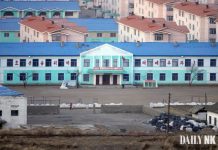[imText1]Since Korean residents in Japan started deserting the Chongryon in their thousands, Chosun Schools, which are affiliated to the organization, also started to come under threat. These schools try to insert North Korean ideology into the minds of the generations which are growing up in Japan.
In particular, the Chongryon takes responsibility for educating people in its anti-South Korea strategy through Chosun Schools; those who are educated go on to play an active role in the Chongryon by aligning their businesses with the Chongryon, other related organizations and the Chongryon central organization, as well as winning over Korean residents in Japan, spearheading the sending of remittances to the North and engaging in espionage activities.
Both the Chongryon and North Korea acknowledge the importance of educating the people in this way, so contribute considerable financial support to the schools. The Chosun Central News Agency (KCNA) has reported that National Defense Chairman Kim Jong Il even sent funds and scholarships to the organization in April 2008. The amount is said to have totaled 205 million Japanese Yen (approximately 2.305 million U.S. dollars) over a series of 154 contributions.
However, despite the support of the North Korean authorities, the number of students has continually decreased. In the 1980s, there were 151 Chosun Schools in the Forty-Seven Japanese Prefectures, including 83 elementary schools, 56 middle schools, 12 high schools and 67 preschools.
Since when, the number of Chosun schools has decreased by approximately two third; in Tokyo the number of middle schools has decreased to just three after a string of mergers and closures.
More than the decreasing number of schools, however, the decrease in the number of students has been conspicuous. In the 1960s, the heyday of the Chongryon, there were around 56,000 students in each school. But by 2005 the number had dropped to approximately 12,000, and now hovers at around 10,000.
Moreover, the phenomenon has been accelerating ever since the nuclear crisis erupted and the abduction of Japanese citizens by the North in the 1970s became common knowledge. In the case of Chosun University, which represents the Chongryun-affiliated Chosun Schools, the size of the student body has dwindled to just 800.
Simultaneously, with domestic donations to schools waning or ceasing altogether, many Chosun Schools have been rushing to merge with other schools or shut down altogether. “Tokyo No. 8 Elementary School” in Setagaya was even sold to avoid foreclosure.
It has also been reported that the Chosun University is also having trouble repaying its debts, said to have reached 4.3 billion yen (approx. 48.342 million U.S. dollars). Financing via donations has apparently become much more difficult, and bonuses to teachers have been withheld.
◆ The Chogin Bank (朝銀) broken by excessive remittances to the North
While the Chosun Schools are supposed to provide human capital to the Chongryon, businesses under the Chongryon are supposed to provide the financial foundations.
But Chongryon-affiliated banks and businesses have been affected by the financial crisis, and a number have gone under, placing the organization itself at risk.
Under the Chongryon there exist 22 organizations such as the Commercial Union, the Credit Association Society, the Youth Alliance, the Women’s Alliance, the Teacher’s Alliance, the Central Educational Committee and other cultural organizations, as well as businesses such as the Central Academy, the Chosun Shinbo, and the Chosun News Agency. The Commercial Union and the Credit Association Society play the actual role of providing the financial foundations for the organization.
In particular, after being hit with sanctions by the Japanese government following illegal remittances to the North, the financial dire straits of the Chongryon got worse. According to reports in the Japanese media, the annual 600-800 million dollars sent to the North in the name of patriotism had been the North’s key means of acquiring foreign currency, but due to the unreliability of those enterprises, the amount of the remittance is supposed to have decreased significantly.
According to a 1990 announcement by the Chosun Credit Association, the total number of deposits by 38 associations and 176 stores reached 2 trillion yen. Chongryon businessmen were playing the main role as the behind-the-scenes supplier of operational funds to the organization.
Specifically, the Chongryun set up a financial institution called Chogin Bank and built up its capital by promoting saving. With the funds, the Chongryon concentrated on financial undertakings such as operating profitable Pachinko machines and buying and selling land.
However, in the 1990s and after, the financial situation of the Chongryon began to deteriorate. At the time, with the North Korean economy approaching rock bottom, the authorities requested funding support from the Chongryon, but due to the recession in the Japanese economy, remittances proved insufficient. The Chosun Credit Association also experienced financial difficulties following a slump in the Pachinko slot machine business and the failure of some property transactions, which had been the chief source of funds. Despite these financial difficulties, the Chongryon continued to remit money to the North, worsening its own financial situation.
Ultimately, due to the Japanese recession and excessive remittances to the North, the Chogin Bank approached the verge of collapse. At its peak, it had 38 branches all over Japan. But the collapse of a bubble in the economy and the ensuing ten years of stagnation led to mergers and closures in various parts of the country.
In early 2000, 15 of 18 credit associations collapsed, though nine began trading under different names. The Chosun Credit Association has been dissolved and Chogin Bank-affiliated banks have been merged or closed, leaving four remaining associations, including the Io Shinkumi Bank and the newly established Hyougo Himawari Shinkumi Bank.
Of the 29 Chosun Schools and Chongryon provincial headquarters located in major cities such as Tokyo and Osaka, nine have been provisionally seized or confiscated by the Corporation, including the offices in East Kyoto and West Tokyo, Chiba Prefecture, Aichi Prefecture, Saga Prefecture and Osaka. Miyake Prefecture, Aichi Prefecture Chosun Middle and High School and the Kyushu Chosun Middle and High School have also been provisionally seized
Finally, last but not least, the Chongryon Central Headquarters Assembly, with its half-century of history, is on the brink of a forced sale. Currently, relevant buildings and property are under the name of a separate joint stock company, and the Resolution and Collection Corporation is preparing a lawsuit.
(to be continued).




















